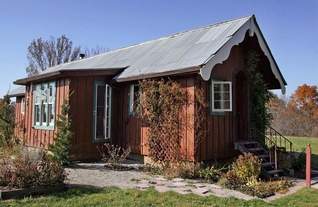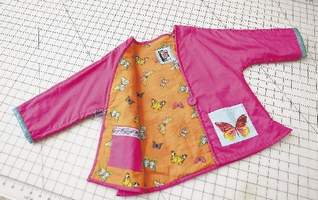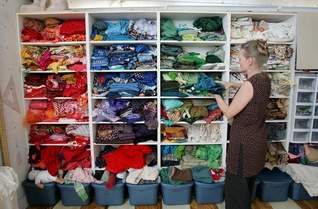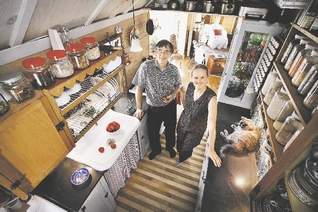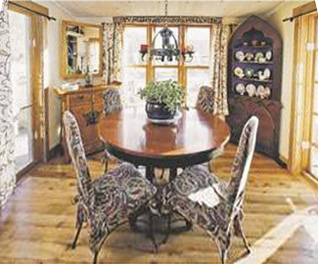Couple find freedom in 'living lightly'
By MIKE KILEN • mkilen@dmreg.com •
November 9, 2008
Tim and Debbie Freeberg-Renwick made a home and a business out of
leftover scraps, an idea not sparked by today's financial and
environmental uncertainty.
It started a few years ago, during a midlife awakening.
Tim
and Debbie had already transformed a rather plain 1920s home in
Fairfield into a charming jewel box, yet the designers sought a new
challenge. It still being the fearless late 1990s, they scratched out
plans for a home double the size, a palace they began to think of as a
"mini-Versailles."
Then a winter ice storm hit. Power went out. The jewel box turned to
an icebox. What a strange way to live, she thought, so vulnerable to
the climate they should work with, not against.
"I was
approaching midlife," debbie said. "I didn't see an endless vista in
front of me, but at the same time, I began to see new possibilities."
That
moment led to new ways of thinking. Today, Tim, 53, and Debbie, 55, are
snug in a wonder of space efficiency and ecology — a 572-square-foot
house largely made from used materials. Last month, Debbie took
recycling a step further, launching Doubletakes, which sells children's
fashions she makes from used clothing.
"Neither of us is a tree-hugger," Tim said. "I've always been suspicious of them. But I'm becoming more sympathetic."
Examination of life
When they began research on building a smaller house, Debbie said she began to feel more connected to her life.
"I
began eagerly examining every aspect of living," she said. "This
naturally led me to a desire to live more lightly and responsibly on
the Earth."
She began an inventory of their material goods and
"ruthlessly" began eliminating them, freeing not only external space
but also internal space, she said. "I began to feel lighter, freer."
Tim
works in furniture design, Debbie in fashion design. The new home
project brought their skills together as they studied the spaces in
houseboats, Gypsy wagons and recreational vehicles. They wanted a
conventional home design, not the earthen or straw-bale homes that have
become popular around Fairfield. It didn't make sense to them in a
wet-soil climate.
It also didn't make sense to buy new materials.
They
began scrounging at auctions, building and demolition sites and garage
sales for used materials to build a home. From a corn crib they
dismantled and hauled away for free came corrugated metal for the roof,
oak framing and slats for floor joists, flooring and kitchen cabinets.
For
$5 at a local auction they got marble slabs for under a wood stove and
window sills, while an old chemistry lab table became kitchen counters.
For $50, an old home netted French doors, window pulls and an eyebrow window.
The inventory grew and plans moved slowly forward.
It's
not easy to build this way and that's why few do it, said Lynnae
Hentzen, executive director of the Center on Sustainable Communities, a
nonprofit in Des Moines that supplies education and resources for
sustainable building.
There is a growing list of retail outlets
in Iowa that sell used materials to build with, but they can be more
expensive than hunting them down yourself.
Our ancestors taught
us that with a lot of elbow grease and patience, we could get it done
ourselves, Hentzen continued. "But we've moved to a quick need-it-now
mindset."
Learned from Chinese
Tim and Debbie's midlife project was interrupted when Tim landed a
job as a consulting engineer for a furniture factory in China in 2000.
"It was a turning point for us," Debbie said.
They
were welcomed by Chinese families living in incredibly small,
well-designed homes. They saw the workers toiling 13-hour days, seven
days a week, to meet the insatiable consumer demands of the world.
"It
jostled the way I look at life," said Debbie, whose clothing business
began to form in her mind. "There has got to be a better way to do
things."
But first, after 2½ years in China, they had to finish their home.
Debbie
grew up in suburban Chicago, and back-to-the-Earth movements meant
little. The couple met in Fairfield 20 years ago when they both moved
there to study transcendental meditation from Maharishi University of
Management instructors. They have since given up TM, but their fresh
ideas smack of the creativity, environmentalism and entrepreneurship
that meditators are known for.
After more antique glass tiles
($50), foam insulation from a Dumpster (free), mirrors from Goodwill
($25) and shelving for bookcases (free) were hunted down, they put the
home on wheels and moved it onto country property they purchased in
2004. The project took more than five years.
Walk through the
front door (free from an old factory) and an elegant foyer with an
arched ceiling to match the eyebrow window is the first example of
space that can feel right, no matter how small.
The storage is
behind sliding doors and panels in the ceiling and walls. The small
kitchen is a model of design, everything within arm's reach. One of
Debbie's big sacrifices was giving up a dishwasher. So they built a
dish rack over a large old sink so wet dishes could easily drain.
Tim viewed the entire enterprise as an engineering puzzle.
The
dining alcove off the kitchen is a pop-out construction, almost like a
pull-behind camper. All they have to do is take out the screws and the
sides slide together to form a flat surface for ease in wheeling to a
new location.
The living room includes space-saving features
such as an old wood trunk that can be opened and its bottom cranked up
to hold a television, which they no longer use. The office is behind a
door in the living room wall, a tray sliding out for a workspace.
The
bedroom? It's behind the faux bookcase in the living room, which is
actually a door that opens to a platform the width of the bed with no
space-eating hallway or even room for an end table. With a vaulted
ceiling, natural light from windows and built-in storage, the room
somehow feels comfortable.
In the rear of the home is a small bathroom and an efficient washer. (The other big sacrifice was a clothes dryer).
They
heat with passive solar, a wood stove and have backup propane. They use
rain off the roof that trickles from wide eaves into a cistern for
their water supply. They're planning on using solar and wind energy.
"It's really how you use space," Tim said.
It's easier to clean and maintain than her prior home, Debbie said. And it cost $10,000 to build.
Thrift stores' treasures
Sustainable building led Debbie to new ways of thinking about
fashion design. What if she bought used clothing at thrift stores to
make new designs?
The hunt for materials began again. She found
used Japanese kimonos and Indian scarves. She found fun vintage buttons
and embroidered shirts. She found wool and fur off coat collars. She
began sewing it all together into children's dresses, coats and skirts
in a 300-square foot studio across the garden from her home.
Refashioning
old clothes has become a small trend across the country, to add spice
to high-society fashion shows and feel-good to those worried about
massive textile waste, which hundreds of recycling businesses now try
to divert from landfills.
Debbie went a step further on the sustainability scale. She made the skirts reversible to become two outfits in one.
She
also listened to friends with children - the Freeberg-Renwicks don't
have kids - who lamented that their children were saddened to grow out
of their favorite, comfortable outfit. So she added a line called Grow
Ups where with a few snips, length can be added.
Most of the
line, launched last month on doubletakesclothing.com, ranges from $95
to $225. Saving the Earth won't always save money in the short term.
But it took Tim and Debbie the long term - and a midlife awakening - to give themselves a bit of certainty in uncertain times.
"Things are going to change but I don't know how," Tim said. "Hopefully, we can go through it without discomfort."
Free or inexpensive supplies
Examples of materials used in the construction of the home of Tim and Debbie Freeberg-Renwick.
Free:
From an old corn crib: corrugated metal for a roof; oak framing and
slats for floor joists, flooring, upper kitchen cabinets, bed cupboard
bookcases and window trim.
Free: From a grain bin's fir ship-lap siding: interior walls, doors, some trim.
$5:
From an auction: marble slabs for under the wood stove and window sills
and kitchen counter material from an old chemistry lab table.
$50: From a 1830s home: French doors, window pulls, eyebrow window.
Free: From a factory scheduled for demolition: front door.
$75: From bits of material of a stained-glass artist: stained glass on front door and bathroom.
$25: From friends who were remodeling: kitchen sink, two bath sinks, 4-foot tub.
Free: From remodeling project: shelving from bookcases.
Free:
From water-damaged tabletops with hand-carved trim from Indonesia:
built a china cabinet for dining room, a bed headboard and the Moroccan
side table.
$25: From Goodwill: large closet mirror.
Trade: From friends: star pulls on drawers, doors, ceiling details.
$50: Antique glass tiles in the bathroom stained glass wall.
Free: From damaged maple flooring: Kitchen floor.
$75: From an auction: TGI's for wall and ceiling framing.
Free:
Styrofoam from commercial building site garage: enough foam insulation
for 6 inches on one wall that is 43 feet long and 7 feet tall and 10
inches on opposite wall.
Free: From wainscoting from an old house: front lower bath sink cabinet.
$50: From Galena, Ill., antique store: front door knob.
$10: From yard sales: fireplace tools.
Free: From a friend remodeling: underlay for foyer ceiling.
Free: From a friend: half of the Marmoleum used for the foyer floor.
Gift: From Chinese friends: hand-carved trim on door.
Free: From friend remodeling: chair rail.
$5: From yard sale: apartment-sized stove.
$5: From yard sale: plate rail over kitchen window.
$150: Trailer for house base.
$75: From local farmer: old metal roofer under floor to keep mice from digging into floor.
$25: From local store remodeling: dining room light fixture.
$250: From Renovator's Supply: tub/shower faucet.
$1.50: From auction: old-fashioned doorbell.
Free: From a friend: stair spindles used at top of wall behind wood stove.
$25: From artist friend: ceramic tiles in kitchen.
Total: Combined with some new materials, the total cost of the construction is roughly $10,000.
Home energy use
The average is 624 kilowatt hours per month for both home and
fashion design workshop at 8 cents per kilowatt hour; 180 gallons of
propane per year for cooking and water heating; water is free from roof
collection into cistern, using 30 to 40 gallons per day; 1-1/2 loads of
firewood for heating at $70 per load.


